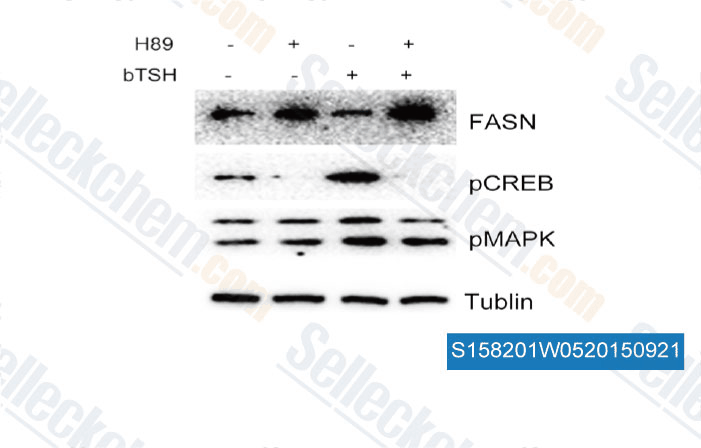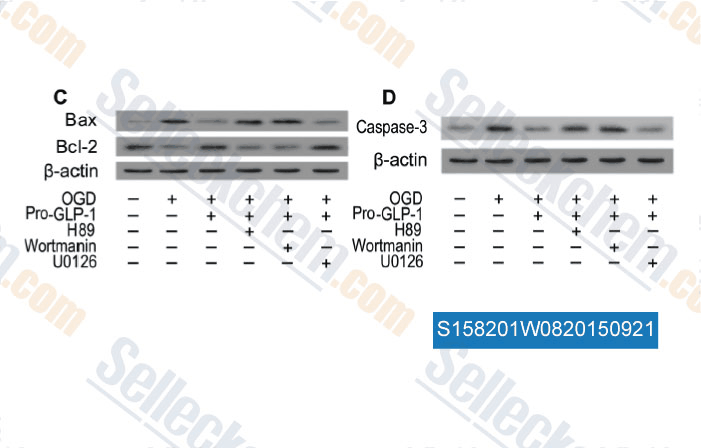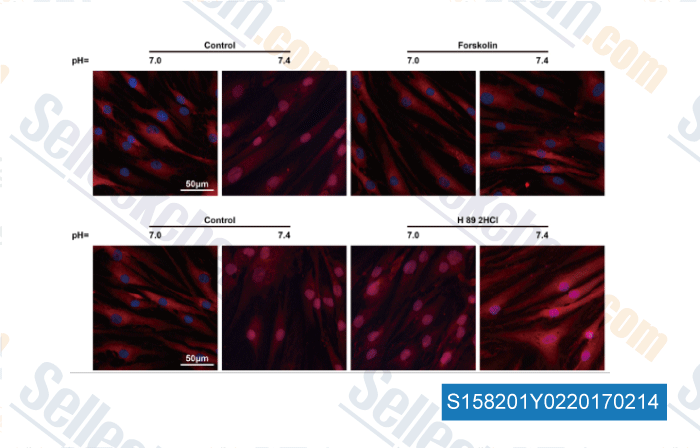|
Toll Free: (877) 796-6397 -- USA and Canada only -- |
Fax: +1-832-582-8590 Orders: +1-832-582-8158 |
Tech Support: +1-832-582-8158 Ext:3 Please provide your Order Number in the email. |
Technical Data
| Formula | C20H20BrN3O2S.2HCl |
|||
| Molecular Weight | 519.28 | CAS No. | 130964-39-5 | |
| Solubility (25°C)* | In vitro | DMSO | 104 mg/mL (200.27 mM) | |
| Water | 6 mg/mL (11.55 mM) | |||
| Ethanol | Insoluble | |||
|
* <1 mg/ml means slightly soluble or insoluble. * Please note that Selleck tests the solubility of all compounds in-house, and the actual solubility may differ slightly from published values. This is normal and is due to slight batch-to-batch variations. * Room temperature shipping (Stability testing shows this product can be shipped without any cooling measures.) |
||||
Preparing Stock Solutions
Biological Activity
| Description | H 89 2HCl is a potent PKA inhibitor with Ki of 48 nM in a cell-free assay, 10-fold selective for PKA than PKG,500-fold greater selectivity than PKC, MLCK, calmodulin kinase II and casein kinase I/II. H 89 2HCl induces autophagy. | ||||||
|---|---|---|---|---|---|---|---|
| Targets |
|
||||||
| In vitro | H89 2HCl is a potent PKA (cAMP-dependent) protein kinase A inhibitor with Ki of 48 nM, exhibits 10-fold selectivity over PKG, exhibits >500-fold selectivity over PKC, MLCK, calmodulin kinase II and casein kinase I/II. Pretreatment of the cells with H-89 (30 μM) 1 h before the addition of forskolin markedly inhibits the forskolin-induced protein phosphorylation in a dose-dependent manner. [1] H89 also inhibits several other kinases with IC50 of 80, 120, 135, 270, 2600 and 2800 nM for S6K1, MSK1, PKA, ROCKII, PKBα and MAPKAP-K1b, respectively. [2][3] H89 also has activity at some cellular receptors and ion channels, including Kv1.3 K+ channels,β1AR and β2AR. [4] |
||||||
| In vivo | H89 causes distinct modifications of protein phosphorylation, with the most robust changes in phosphorylation are fructose-1,6-biphosphatase, heterogeneous nuclear ribonucleoprotein (hnRNP), NSFL1 cofactor p47, all which have potentially regulatory connections to cAMP/PKA. [5] |
Protocol (from reference)
| Kinase Assay: |
|
|---|---|
| Cell Assay: |
|
| Animal Study: |
|
References
Customer Product Validation

-
Data from [Data independently produced by , , J Cell Physiol, 2015, 230: 2233-2239]

-
Data from [Data independently produced by , , Eur J Pharm Sci, 2015, 70C: 82-91 ]

-
Data from [Data independently produced by , , Sci Rep, 2016, 6:26835.]
Selleck's H 89 2HCl has been cited by 187 publications
| Adenylate cyclase 10 promotes brown adipose tissue thermogenesis [ iScience, 2025, 28(2):111833] | PubMed: 39949963 |
| Malate initiates a proton-sensing pathway essential for pH regulation of inflammation [ Signal Transduct Target Ther, 2024, 9(1):367] | PubMed: 39737965 |
| The subcortical maternal complex modulates the cell cycle during early mammalian embryogenesis via 14-3-3 [ Nat Commun, 2024, 15(1):8887] | PubMed: 39406751 |
| Proton pump inhibitors enhance macropinocytosis-mediated extracellular vesicle endocytosis by inducing membrane v-ATPase assembly [ J Extracell Vesicles, 2024, 13(4):e12426] | PubMed: 38532609 |
| Proton pump inhibitors enhance macropinocytosis-mediated extracellular vesicle endocytosis by inducing membrane v-ATPase assembly [ J Extracell Vesicles, 2024, 13(4):e12426] | PubMed: 38532609 |
| Automated, High-Throughput Phenotypic Screening and Analysis Platform to Study Pre- and Post-Implantation Morphogenesis in Stem Cell-Derived Embryo-Like Structures [ Adv Sci (Weinh), 2024, 11(4):e2304987] | PubMed: 37991133 |
| Activation of hepatic adenosine A1 receptor ameliorates MASH via inhibiting SREBPs maturation [ Cell Rep Med, 2024, 5(3):101477] | PubMed: 38508143 |
| PTGER4 signaling regulates class IIa HDAC function and SPINK4 mRNA levels in rectal epithelial cells [ Cell Commun Signal, 2024, 22(1):493] | PubMed: 39396982 |
| Hepatocyte GPCR signaling regulates IRF3 to control hepatic stellate cell transdifferentiation [ Cell Commun Signal, 2024, 22(1):48] | PubMed: 38233853 |
| Maternal obesity may disrupt offspring metabolism by inducing oocyte genome hyper-methylation via increased DNMTs [ Elife, 2024, 13RP97507] | PubMed: 39642055 |
RETURN POLICY
Selleck Chemical’s Unconditional Return Policy ensures a smooth online shopping experience for our customers. If you are in any way unsatisfied with your purchase, you may return any item(s) within 7 days of receiving it. In the event of product quality issues, either protocol related or product related problems, you may return any item(s) within 365 days from the original purchase date. Please follow the instructions below when returning products.
SHIPPING AND STORAGE
Selleck products are transported at room temperature. If you receive the product at room temperature, please rest assured, the Selleck Quality Inspection Department has conducted experiments to verify that the normal temperature placement of one month will not affect the biological activity of powder products. After collecting, please store the product according to the requirements described in the datasheet. Most Selleck products are stable under the recommended conditions.
NOT FOR HUMAN, VETERINARY DIAGNOSTIC OR THERAPEUTIC USE.
